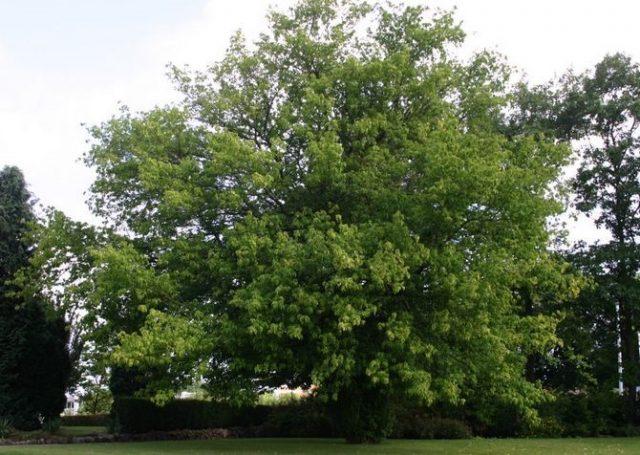Content
Ash and ash-leaved maple can be seen almost everywhere. Tall and powerful tree trunks are found in parks and on city streets. And although they are very similar, it is easy to distinguish ash from ash-leaved maple by several signs at once.

The openwork crown of the ash tree lets in a lot of sunlight
What is the difference between maple and ash
The trees belong to different families: maple - Sapindaceae, ash - Olive. Accordingly, morphological characteristics may differ significantly. However, they are often confused, especially at the everyday level.
What kind of leaves do ash and maple have?
The leaves of trees differ in their structure:
Ash. On a common leaf stalk up to 40 cm long, small sessile leaves grow separately in the amount of 7-15 pieces. They are 4-9 cm long, dark green, lanceolate in shape. The top is without pubescence, the midrib is depressed. Protruding white veins are visible below. In general they resemble rowan leaves.
Ash-leaved maple. Compound, imparipinnate leaves usually have 3-7 leaflets, less often up to 13. They are up to 15-18 cm long and grow on long petioles, up to 8 cm. The edge is rough-serrate, but overall the surface is smooth, the top is light green, the bottom is silvery-white, pale. The teeth are asymmetrical, the last leaf is larger than the rest.

American maple leaves have long petioles

Ash has sessile leaves and practically no petiole.
Crown comparison
The crown makes it much easier to determine the type of tree. In ash it is elongated-ovate, wide-round. The tree grows to a height of 25-30 m (up to 60 specimens are known). The branches are large, arched, directed strictly upward. Rarely appear on the trunk.
Ash-leaf maple (American) usually grows to a height of 12-15 m, sometimes up to 25. The crown is uneven, up to 15 m in diameter. The trunk is short, divided at the bottom into several curved, spreading and long branches, growing unevenly in different directions.

The crown of the American maple has a “disheveled” appearance

Ash branches grow vertically, forming a neatly aligned crown
What fruits do ash and maple have?
The fruits of both ash and American maple are called lionfish. In the first, they are single, elongated elliptical in shape, 3-4 cm long, rounded at the base, similar to an airplane propeller blade. The seed is an oblong flat nut with grooves, almost equal in length to the length of the lionfish.
In the ash-leaf maple (American), the lionfish consists of two fused wings about 4 cm long, each of which contains one seed. They are located at an acute angle to each other. The seeds are elongated, their length is twice as wide as their width. The surface is heavily wrinkled.
The difference between the lionfish of ash and ash-leaved maple is clearly visible in the photo:

A single ash lionfish has a small notch at the top

The American maple lionfish remains on the branch almost until spring
Spreading
Maple and ash grow in almost all natural zones, except for the tundra and forest-tundra in the north and the tropics in the south.In Russia, the northern border of ash growth does not pass above the Leningrad region, and outside the country - along the coast of Norway. American maple has recently been found even in Vorkuta; its frost resistance reaches -45 °C.
Both species grow well in moist soils, old beams, and lowlands with high groundwater levels. In the Moscow region and throughout the Central and Central Black Earth regions, trees grow up to 25 m, in the south - higher. Suitable climatic conditions for maple and ash exist in the Volga region, the North Caucasus and Transcaucasia.
Application
Ash wood is elastic and durable. In ancient times, spears, arrows, clubs were made from it, and dishes were turned out. Nowadays it is used to produce boards and plywood with a beautiful texture for making furniture.
Billiard cues, racing boat oars, gymnastics bars, and high-quality skis are all made from this wood. Seeds containing up to 30% fat can be used as animal feed.

Birds in forests actively feed on ash fruits
Ash has become widespread in urban landscaping and landscape design. Planted along roads and railway tracks, trees trap dust, exhaust gases, and harmful emissions from road surfaces.
The wood of the American ash-leaved maple does not have valuable qualities. It has a fibrous light structure that is difficult to process. It is used mainly for the production of wooden containers; it is not used as firewood, because it has high humidity and therefore requires long-term preliminary drying.
It is currently not used in urban landscaping due to its instability to strong winds. Overgrowth can break through asphalt and spoil the appearance of lawns.

American maple pollen is a strong allergen
On old, disease-damaged trunks and stumps of American trees, growths (burls) can often be seen. They are of interest to those involved in decorative arts. A beautiful pattern appears on the cut of the burls, sometimes with pink or reddish streaks. Handles of hunting knives, small decorative sculptures, and bowls are made from them.
What to choose
There is no doubt that ash is superior to the ash-leaved prototype in many respects. The latter is not used in landscaping, and is not even suitable for firewood. It occupies one of the first places on the list of dangerous plants along with hogweed.
Warning! American maple has the ability to poison all surrounding plants and even its own shoots with its phytotoxins from decaying wood.
Conclusion
It is quite possible to distinguish ash from ash maple. And even necessary in some cases. If a small American maple plant suddenly appears on the site, you need to get rid of it immediately, otherwise its offspring will fill the entire perimeter.








